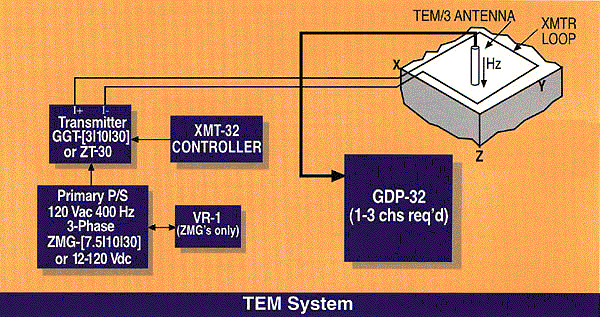


|
Home Equipment Services | Field Surveys | | CR | | RPIP, TDIP | | ERT | | CSAMT | | AMT, MT | | TEM | | NanoTEM | | Streaming IP | | Seismic | | Laboratory | Applications | Consulting | Lab Properties | Ore Minerals Software About Us Contact News |
|
3322 E Fort Lowell Rd |

Field Surveys
TEM
Transient Electro-Magnetic

Each equipment box in the diagram above is linked to the corresponding specification file.
Applications:
- Mining Exploration
- Geothermal Exploration
- Static Corrections for MT/AMT
Papers and Case Histories
Introduction to TEM
[Abstract]
[Paper PDF:198k]
The transient electromagnetic or TEM technique, which is sometimes called time-domain EM (TDEM) or pulse EM (PEM, EMP), can be used for vertical depth sounding or profiling. The equipment consists of a transmitter and receiver which can be contained in a single box (with an external power source for the transmitter) or used with separate transmitter and receiver enclosures. The depth of exploration attained in a vertical sounding configuration can vary from 10's of meters to over 1000 meters, depending upon transmitter loop size, available power from the transmitter, and ambient noise levels.
Improved near surface mapping in groundwater studies: Application of fast sampling time domain EM surveying methods
[Abstract]
[Paper PDF:684k]
There are a limited number of methods currently in use to gather information on the various hydrogeological/environmental problems that are part of "everyday" life. Traditionally, groundwater problems have been evaluated and then monitored using a carefully designed network of wells where water depth and quality are measured on a regular basis. In recent years, some of the various mining and petroleum oriented geophysical techniques have been modified from their deeper applications to sample at shallower depths. Often the goal of these surveys is to help geologists and engineers determine whether their assumptions on well location and water flow are correct. Techniques that have been used include shallow seismics, DC resistivity, ground penetrating radar, frequency domain electromagnetics (FDEM), and time domain electromagnetics (TEM).
Recent advances in sampling speed, circuitry speed, and data recording have allowed the development of TEM techniques where data can be taken faster (and therefore start closer to the surface), and with better resolution of the top 15-50 m. These techniques include the Zonge Engineering NanoTEM system and the fast sampling modifications to the SIROTEM-3 system.
This paper briefly summarises the TEM results from three separate study areas encompassing a range of hydrogeological and environmental problems, each of some immediate importance in Australia at this time. The first study, at the Stockyard Plain Disposal Basin (SPDB) near Waikerie, South Australia, examines the changing hydrological environment around a groundwater disposal basin in the Murray-Darling system. The second study, in the Willaura Catchment in Victoria, examines water mobility in an evolving dryland salinity system. The third study, at an abandoned mine site in New South Wales, attempts to delineate the extent of acid-mine drainage in the area around the mine.
Target Prioritization In TEM Surveys For Sub-Surface UXO Investigations Using
Response Amplitude, Decay Curve Slope, Signal To Noise Ratio, And Spatial Match Filtering
[Abstract]
[Paper PDF:85k]
To reduce the number of false-positives in identifying UXOs and related debris for ongoing Site Investigation, a target prioritization routine was developed based on the likelihood of a metallic source. Numerous parameters were evaluated statistically using over 2000 existing intrusive investigation results. Those showing the best ability to discriminate between metallic and non-metallic sources were incorporated into the scheme, including peak amplitude response, power-law decay slope, signal to noise ratio, and spatial match filter response. Parameters were assigned increasing numeric values based on likelihood of a metallic source, and summed to produce a target rank. Subsequent application to over 4000 new intrusive investigations revealed that the highest ranked 25% of targets were nearly five times more likely to yield a metallic source when investigated than the lowest ranked 25%. These results show that target selection routines in UXO investigations would benefit from using more parameters than just magnitude response, allowing more aggressive target identification and reduced costs by lowering the number of false positives that are investigated. Proposed refinements may further increase predictive capabilities.
Fast TEM for UXO mapping at Gambell, Saint Lawrence Island, Alaska
[Abstract]
[Paper PDF:514k]
A fast-sampling, Transient Electromagnetic (TEM) system was assembled for mapping probable UXO submerged in a shallow fresh-water lake near Gambell, Saint Lawrence Island, Alaska. The survey was designed to generate optimal data given the survey area, UXO characteristics, and the required depth of exploration. Since the search area was a fresh-water lake in an arctic climate, the survey was conducted in early May. The lake ice was still sufficiently thick to provide safe access, but most of the snow cover had melted, making it easy to move equipment across the search area. A continuous-sampling TEM system that records averaged data every three seconds was mounted on a sled and towed at a slow walk by the equipment operator. A real-time differential GPS unit recorded the sled's location every five seconds. Using this system, a total of 426,000 line-feet of profile with an average sample interval of 7.5 ft were surveyed over a period of 14 days. At each sample point, vertical-component transient data were recorded at 26 delay times, ranging from 7 to 570 microseconds. In this paper, we describe in detail the design of the antenna system and the survey. Area maps of the TEM response at several gates are presented. Using the maps and transient profile plots, target locations were picked. Analysis of the transient decay curves observed over the targets provides additional information about target size and conductivity.

